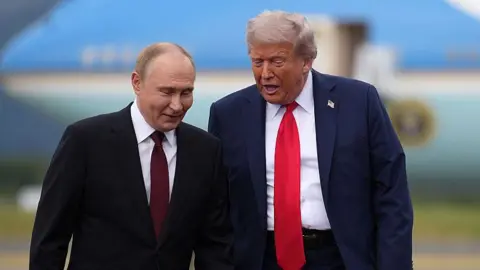The ongoing conflict between Russia and Ukraine continues to pose significant diplomatic challenges, recently highlighted by interactions among key figures, including Russian President Vladimir Putin, Ukrainian President Volodymyr Zelensky, and former U.S. President Donald Trump. A recent article discusses the Kremlin’s response to talks of a potential summit between Putin and Zelensky, while Trump has reiterated the idea of a bilateral meeting as a means to discuss and potentially resolve the war in Ukraine.
The Kremlin has been cautious in addressing the prospects of a summit, with statements suggesting a reluctance to engage in discussions that may not lead to substantial outcomes. Trump, meanwhile, appears to maintain a proactive stance, advocating for the two leaders to meet after his recent discussions with both Putin and Zelensky. Trump acknowledged that the situation is complex, labeling it as a “tough one” and indicating that Putin might not be interested in reaching an agreement. He remarked on the forthcoming weeks, implying that an understanding of Putin’s willingness to negotiate would become clearer over time.
The context of these discussions is significant. Trump’s encounters with European leaders and Zelensky at the White House, combined with his meeting with Putin in Alaska, suggest an intricate web of diplomatic effort aimed at reducing hostilities in Ukraine. Trump’s admission of the difficulties in resolving the conflict reflects an evolving perspective based on the realities portrayed by leaders from Ukraine and its European allies.
Compounding the complexities of the situation, Putin’s openness to direct negotiations with Ukraine has been met with skepticism due to differing statements from his officials. Russian Foreign Minister Sergei Lavrov’s comments about a gradual preparation for any meeting indicate a cautious and calculated approach on the part of Moscow, which has historically prioritized control over negotiation processes.
Despite expressions of potential openness, Russian engagements indicate preconditions that Ukraine might find unacceptable. The idea of Zelensky traveling to Moscow for talks, as suggested by Putin, stands as a largely impractical expectation for Ukraine at this juncture. This proposal may reflect Russia’s desire to frame the dialogue in a way that does not genuinely address the critical issues at hand.
In recent engagements, Trump has also shown an awareness of the vast disparities between the demands of Moscow and the stances adopted by Kyiv. His earlier assertions about securing a ceasefire have not materialized; instead, he now suggests that a permanent peace deal may be more advantageous in the current context, along with necessary security guarantees for Ukraine. This marks a shift from an immediate ceasefire to a focus on a more formalized peace agreement.
The responses from European leaders further illustrate the diverse outlook on the potential for negotiations. Zelensky has expressed openness to various formats of meetings with Putin, and European diplomats continue to advocate for dialogue. However, statements from leaders like French President Emmanuel Macron, who described Putin with dismal characterization, indicate a shared skepticism among European nations regarding the Russian leader’s intentions towards peace.
In the midst of these evolving dynamics, questions about the commitment of the U.S. to support European allies and their response strategies loom large. Trump’s discussions surrounding air support in the event of a peace agreement, although still vague, indicate a willingness to assist within limited parameters while avoiding direct military engagement.
Thus, in summary, the intricate geopolitical landscape involving the conflict in Ukraine reveals a cautious diplomatic environment where leaders are navigating a complex series of expectations, demands, and historical tensions. With various stakeholders involved, the possibility of a resolution remains tenuous, and the upcoming weeks may hold critical revelations regarding the willingness of both Russia and Ukraine to engage in true dialogue aimed at peace. The influence of external parties, especially the United States and European allies, continues to shape the trajectory of this evolving conflict.












